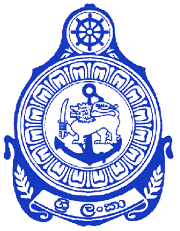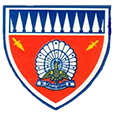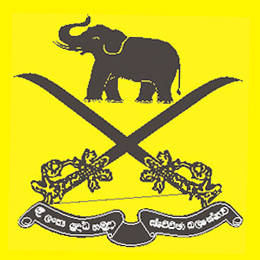The Ceylon Defence Force (CDF) was established in 1910 by the Ceylonese legislation Ceylon Defence Force Ordinance, which reformed the Ceylon Volunteer Force (CVF) that existed previously as the military reserve in the British Crown colony of Ceylon. At the time of forming it was only a reserve force but soon developed into a regular force responsible for the defence of Ceylon. The CDF was under the command of the General Officer Commanding, Ceylon of the British Army in Ceylon if mobilised. However mobilisation could be carried out only under orders from the Governor.
After the outbreak of the Second World War, in the British Crown Colony of Ceylon, the government of Sir Don Baron Jayatilaka assured the British King and his government of its continued support.

The Sri Lanka Navy (SLN) is the naval arm of the Sri Lanka Armed Forces and is classed as the country's most vital defence force due to its island geography and is responsible for the maritime defence of the Sri Lankan nation and its interests. The role of the Sri Lanka Navy is to conduct operations at sea for the defence of the nation and its interests and conduct prompt and sustainable combat operations at sea in accordance with the national policies.

The Sri Lanka Army is the oldest and largest of the Sri Lanka Armed Forces. Established as the Ceylon Army in 1949, it was renamed when Sri Lanka became a republic in 1972. In 2010, the Army had approximately 200,000 regular personnel, between 20,000 and 40,000 volunteer personnel and 18,000 National Guardsmen and comprises 13 divisions, one air-mobile brigade, one commando brigade, one special forces brigade, one independent armored brigade, three mechanized infantry brigades and over 40 infantry brigades.

The Sri Lankan Armed Forces award medals and their associated ribbon bars in recognition of various levels of service, personal accomplishments and commemorative events while a regular- or volunteer serviceperson is a member of the Sri Lanka Army, Sri Lanka Navy and the Sri Lanka Air Force. Together with military badges, such awards are a means to outwardly display the highlights of a serviceperson's career.

The Karyakshama Seva Vibhushanaya is a medal awarded to commissioned officers of the Sri Lanka Army Volunteer Force. Established on 7 January 1986, it replaced the Efficiency Decoration (Ceylon) with effect from 22 May 1972 with volunteer officers who have completed the stipulated required years of service qualifying to the award. Since 2020, with the Karyakshama Seva Padakkama becoming opened to all ranks, the KSV became limited to award for senior volunteer officers.

The Gemunu Watch (GW) ("King Dutugemunu's Own") is a infantry regiment of the Sri Lanka Army, formed with troops from the Ceylon Light Infantry and the Ceylon Sinha Regiment in 1962. It has been deployed in many major operations against the LTTE. It is made up of 14 regular units and 9 volunteer units. Headquartered at Kuruwita Army Camp, Ratnapura. It is named after one of the most famous Lankan Kings, King Dutugemunu.
The National Cadet Corps (NCC) is a youth organisation in Sri Lanka, sponsored by the Ministry of Defence, which operates in schools, and normally includes Army, Navy and Air Force sections. The corp is open for secondary school students on voluntary basis and its officers are government teachers and educational administrators, who serve as instructors. The Cadets are given basic military training in small arms and parades, as well as leadership training.

The Sri Lanka Army Volunteer Force (SLAVF) is the active-duty volunteer reserve force of the Sri Lanka Army. The SLAVF is separate from the Regular Force which consists of personal who are professional soldiers and its Regular Reserve, which comprises personal who have a mobilization obligation following their service in the regular army. The SLAVF consists of the volunteer force and the volunteer reserve; administration and recruitment of reserve personal is carried out by the Volunteer Force Headquarters in Shalawa, Kosgama which is headed by the Commandant of the Volunteer Force. It has a current strength of about 55,000 personnel. The SLAVF was known as the Ceylon Volunteer Force from 1949 to 1972 and the Sri Lanka Volunteer Force from 1972 to 1985.

Ceylon was an independent country in the Commonwealth of Nations from 1948 to 1972, that shared a monarch with other dominions of the Commonwealth. In 1948, the British Colony of Ceylon was granted independence as Ceylon. In 1972, the country became a republic within the Commonwealth, and its name was changed to Sri Lanka.

The Prashansaniya Seva Vibhushanaya is a military decoration awarded to officers of the Sri Lanka Volunteer Naval Force in recognition of excellent service. Inaugurated on 31 January 2000, the medal does not confer any individual precedence. It is equivalent to the Reserve Decoration of the Royal Navy, volunteer officers of the Ceylon Royal Naval Volunteer Reserve had been awarded the Decoration for Officers of the Royal Naval Volunteer Reserve from 1938 to 1950.
The Prashansaniya Seva Padakkama is a medal awarded by the Military of Sri Lanka to all noncomissioned officers and seamen of the Sri Lanka Volunteer Naval Force in recognition of "long, meritorious, loyal, valuable, service and unblemished conduct". It was established on 31 January 2000, and does not confer any individual precedence. Other ranks of the Ceylon Royal Naval Volunteer Reserve had been awarded the Royal Naval Volunteer Reserve Long Service and Good Conduct Medal from 1938 to 1950.

The Sri Lanka Armed Services Long Service Medal is a service award presented to all ranks of the tri-forces of Sri Lanka. Service personnel are eligible for the award on the completion of 12 years' continuous service with perfect character and discipline.
Rear Admiral Rajanathan Kadiragamar, MVO was a Ceylonese flag officer. He was the second Ceylonese Captain of the Royal Ceylon Navy from 1960 to 1970 and as such the longest serving Commander of the Navy.

Sir Susantha de Fonseka KBE was a Ceylonese statesman and diplomat. He was the Deputy Speaker of the State Council of Ceylon and following Ceylon's independence from Britain his first Ambassador to Burma and first Ambassador to Japan. De Fonseka took an active part in the country's struggle for universal suffrage and self-determination.
Commodore G. E. S. de Silva, PSV, FCMA, CFA, FCMI, was a Sri Lankan Volunteer Naval officer, accountant and athlete. He was the former Commanding Officer, VNF.
Rear Admiral D. V. Hunter was a Sri Lankan naval officer, who served as the 7th Commander of the Sri Lankan Navy.
Rear Admiral Gerard Royce Maxwell De Mel, OBE was a Ceylonese admiral. He was the Captain of the Royal Ceylon Navy from 1955 to 1961, the first Ceylonese to hold the post. He was accused and convicted in the 1962 Ceylonese coup d'état attempt.
The Ceylon Royal Naval Volunteer Reserve was the volunteer naval reserve of the British Crown colony of Ceylon from 1938 to 1950. Established as the Ceylon Naval Volunteer Force (CNVF) on 1 January 1938 under the Naval Volunteer Ordinance, No, l of 1937. It was made up of volunteers mainly from the mercantile sector of Colombo consisting of 12 officers and 18 sailors, under the command of the newly commissioned Commander W. G. Beauchamp. The first headquarters of the force was set up on 11 January 1939, just before the outbreak of World War II, at Kochchikade.










